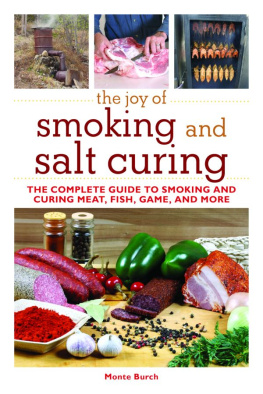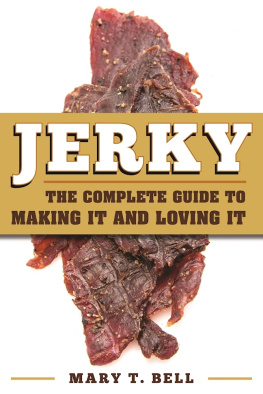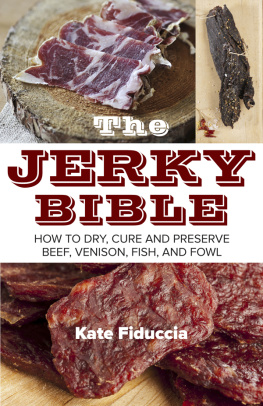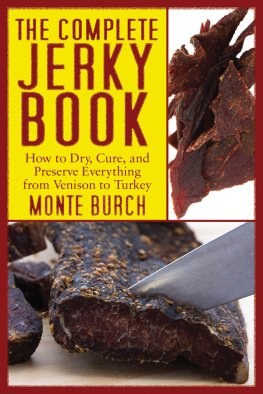
ABOUT THE AUTHOR
A. D. Livingston claimed to have hopscotched through life. Navy at seventeen. Mechanical engineering at Auburn. Atomic bombs at Oak Ridge. Creative writing at University of Alabama. Missiles and rockets at Huntsville. Published a novel and played a little poker. Travel editor at Southern Living magazine. Freelance writing and outdoor photography. Word man for fishing rods and bait-casting reels with Lew Childre, the genius of modern fishing tackle. Bought the family farm. Lost the back forty publishing Bass Fishing News . Lost the rest of the farm manufacturing fishing lures. Back to freelancing. Published twenty-some books. Food columnist for Grays Sporting Journal . All his life he loved to hunt and fish and to cook and eat the bounty. And he loved to write about it his way.
A. D. LIVINGSTONS
BIG BOOK OF MEAT
Other Cookbooks by A. D. Livingston
Jerky
Sausage
Cold-Smoking & Salt-Curing Meat, Fish & Game
Cast-Iron Cooking
The Curmudgeons Book of Skillet Cooking
Complete Fish & Game Cookbook
The Freshwater Fish Cookbook
Venison Cookbook
The Whole Grain Cookbook

An imprint of Globe Pequot
Distributed by NATIONAL BOOK NETWORK
Content from Jerky copyright 2001, 2011, 2018 by A. D. Livingston
Content from Sausage copyright 1998, 2011, 2018 by A. D. Livingston
Illustrations by Jonathan Milo
Cold-Smoking & Salt-Curing Meat, Fish & Game copyright 1995, 2011, 2018 by A. D. Livingston
Illustrations copyright 1995 by Manuel F. Cheo
Specific acknowledgments to individuals, other books, and authors are made in the text as appropriate. A few of the recipes and a little of the text were used, in slightly altered form, in the authors column for Grays Sporting Journal.
All rights reserved. No part of this book may be reproduced in any form or by any electronic or mechanical means, including information storage and retrieval systems, without written permission from the publisher, except by a reviewer who may quote passages in a review.
British Library Cataloguing in Publication Information Available
Library of Congress Cataloging-in-Publication Data Available
ISBN 978-1-4930-2602-9 (paperback)
ISBN 978-1-4930-3452-9 (e-book)
 The paper used in this publication meets the minimum requirements of American National Standard for Information SciencesPermanence of Paper for Printed Library Materials, ANSI/NISO Z39.48-1992.
The paper used in this publication meets the minimum requirements of American National Standard for Information SciencesPermanence of Paper for Printed Library Materials, ANSI/NISO Z39.48-1992.
Printed in China
INTRODUCTION
Jerky is simply raw meat that has been slowly dried at a low temperature. As the water is removed, the meat loses both weight and volume. What it doesnt lose, however, is flavor. In fact, the flavor of the meat is greatly concentrated, which might explain why just about everybody with good teeth loves jerky.
These days jerky is popular as a snack, and it also comes in handy as a high-energy food for backpackers, dogsledders, trail walkers, hunters, anglers, boaters, and other people who spend lots of time outdoors. For long-distance runners and sports competitors, jerky can deliver a burst of energy all out of proportion to its compact size and light weight. For campers, jerky is easy to pack and store. On an auto trip, jerky is great for the kids and doesnt make a mess in the car, and, of course, its perfect for snacking during the football game or television showsand for sneaking into movie theaters that dont allow their patrons to bring their own popcorn. Family dogs savor the stuff, too, if my Nosher is a good representative.
Indeed, modern man eats jerky by the ton, piece by savory piece. Its available these days in supermarkets and outfitter shops and through mail-order catalogs and online retailersand even in corner convenience stores. In other parts of the world, freshly made jerky is often sold at wayside stands and by street vendors. More and more people are making it at home these days, in this country and abroad, and packets of jerky seasoning mixes are sold in sausage and jerky supply catalogs and at the meat counters of large supermarkets.
These days deer hunters are perhaps Americas greatest jerky makers, in terms of volume, because they sometimes have large amounts of meat to preserve and because jerky seems to be a popular chew among this group. Also, a lot of dehydrated-food buffs many of whom have purchased expensive food dehydrators and vacuum-pack systems for home useare especially interested in making their own jerky.
Historically, jerky making is usually attributed to the American Indian, who made good use of it to store buffalo and other meats for future use and for journey food. But jerky really wasnt first invented in the Americas. It has been made around the world since the time of the caveman, and records of its use date back as far as the ancient Egyptians. Before the invention of canning and refrigeration, drying was the only way to preserve meat.
Jerky is still a practical way of preserving meat for future use. Yet modern man, for the most part, has taken to jerky for a more epicurean reason: Jerky simply tastes good and lasts longer, as a chew, than other foods or snacks. And since jerky is made from low-fat cuts of meat, it is also healthier than most junk food.
As a practitioner, I believe that the very best jerky is made at a low temperature over a long period of time. There are, however, other opinions and practical considerations in this matter. If truth be told, theres simply more than one way to jerk meat. Recipes abound, and techniques vary. Experts set forth conflicting information in books and magazine articles. Practitioners argue hotly, head to head. In truth, just about every jackleg jerky maker has something to share, as well as secrets to keep, and I hope the variety of recipes and methods in this book, old and new, will prove to be interesting and helpful. These variations will be discussed in more detail in the chapters that follow, along with suitable recipes. Meanwhile, here is some information that applies to all jerky making.
The Shape of Jerky
Most jerky these days is cut into thin strips. True, some commercial jerky is made in rather jagged pieces, but most of it is made in a more uniform size. Pressed jerky, which is made from ground or chopped meat, is almost always quite uniform. The strips of meat usually run 5 to 6 inches long by 1 inch wide, and often less than inch thick; when the strips of meat are dried, the dimensions shrink considerably. In any case, the length and width of the strips arent nearly as important as the thickness, which greatly influences how long the jerky should be dried and how it will be eaten. Thick jerky tends to make a better chew and lasts longer, but thin requires less drying time and is easier to chew for quick consumption.
Cutting the Meat
A sharp knife is the jerky makers best friend. I always prefer blades made of carbon steel, because they can easily be sharpened with the aid of a good Arkansas whetstone. Modern stainless-steel knives and various sharpening devices fall into the gadget category. If you dont believe me, talk with some professional butchers who dont sell cutlery.
Next page







 The paper used in this publication meets the minimum requirements of American National Standard for Information SciencesPermanence of Paper for Printed Library Materials, ANSI/NISO Z39.48-1992.
The paper used in this publication meets the minimum requirements of American National Standard for Information SciencesPermanence of Paper for Printed Library Materials, ANSI/NISO Z39.48-1992.